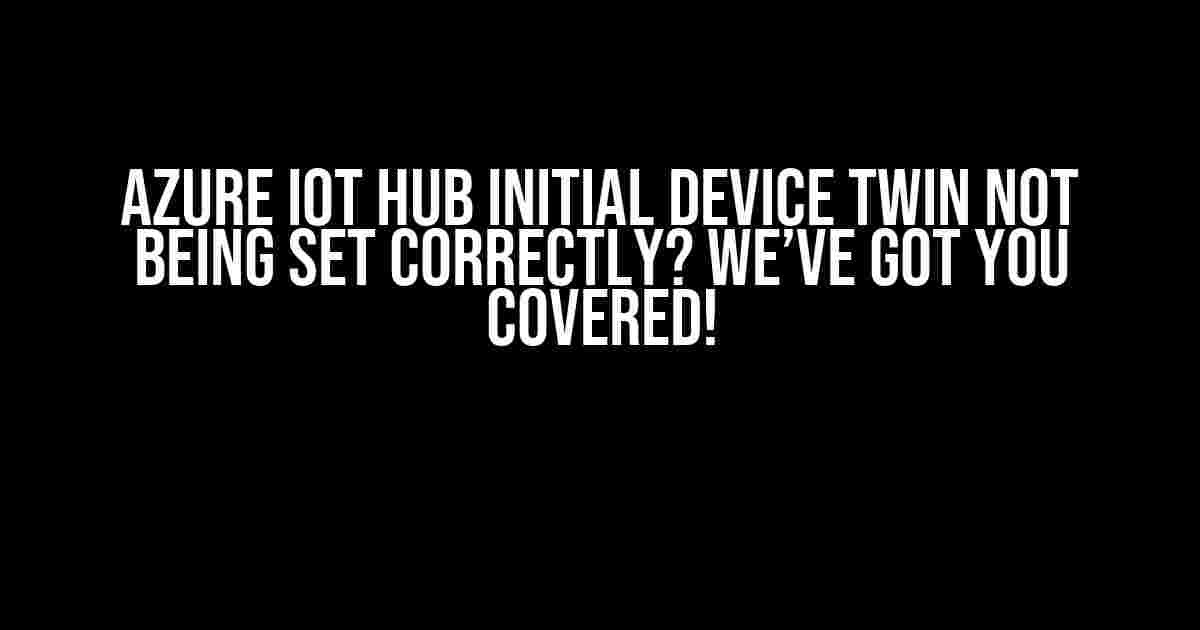Are you struggling to set up your Azure IoT Hub device twin correctly? Don’t worry, you’re not alone! In this article, we’ll dive deep into the world of IoT device twins and provide you with a step-by-step guide on how to troubleshoot and set up your initial device twin correctly.
What is an IoT Device Twin?
An IoT device twin is a digital representation of a physical IoT device. It’s a JSON document that stores device metadata, such as device properties, configuration, and state. The device twin is used by Azure IoT Hub to manage and communicate with your IoT devices.
Why is the Initial Device Twin Important?
The initial device twin is crucial because it sets the foundation for how your IoT device will interact with Azure IoT Hub. If the initial device twin is not set correctly, you may experience issues with device connectivity, data processing, and overall IoT solution functionality.
Before we dive into the solution, let’s take a look at some common issues that may occur when setting up the initial device twin:
- Device twin not being created or updated correctly
- Device twin properties not being reflected in Azure IoT Hub
- Device twin state not being updated correctly
- Device connectivity issues due to incorrect device twin setup
Troubleshooting Steps for Initial Device Twin Setup
-
Check Azure IoT Hub Configuration
Make sure you have created an Azure IoT Hub instance and configured it correctly. Verify that you have the correct connection string, device ID, and authentication method.
HostName=.azure-devices.net;DeviceId= ;SharedAccessKey= -
Verify Device Code and SDK
Ensure that you are using the correct device code and SDK for your IoT device. Check that you have the latest version of the Azure IoT Hub device SDK installed.
// C# device SDK example using Microsoft.Azure.Devices.Client; DeviceClient deviceClient = DeviceClient.CreateFromConnectionString(connectionString); -
Check Device Twin Properties and Tags
Verify that you are setting the correct device twin properties and tags in your device code. Make sure to use the correct data types and formats.
Property/Tag Data Type Description deviceId string Unique device identifier deviceType string Device type or category location object Device location (latitude, longitude, etc.) -
Use the Correct Device Twin Update Method
Ensure that you are using the correct method to update the device twin. You can use the
UpdateTwinAsyncmethod to update the device twin.// C# device SDK example Twin twin = new Twin(deviceId); twin.Properties.Desired["deviceType"] = "temperatureSensor"; await deviceClient.UpdateTwinAsync(twin); -
Verify Azure IoT Hub Device Twin Update
Check the Azure IoT Hub portal to verify that the device twin has been updated correctly. You can use the Azure IoT Hub explorer or the Azure portal to view the device twin.
Best Practices for Initial Device Twin Setup
FOLLOW THESE BEST PRACTICES TO ENSURE A SUCCESSFUL INITIAL DEVICE TWIN SETUP:
- Use a consistent naming convention for device IDs and twin properties
- Use the correct data types and formats for twin properties and tags
- Use the Azure IoT Hub device SDK to simplify device twin setup and management
- Verify device twin updates regularly to ensure correct setup and configuration
- Use Azure IoT Hub explorer or the Azure portal to monitor and debug device twin issues
Conclusion
Setting up the initial device twin correctly is crucial for a successful IoT solution. By following the troubleshooting steps and best practices outlined in this article, you can ensure that your IoT device twin is set up correctly and ready for action. Remember to verify your device twin setup regularly and use the Azure IoT Hub device SDK to simplify the process.
Happy coding and IoT-ing!
This article provides a comprehensive guide on how to troubleshoot and set up the initial device twin correctly in Azure IoT Hub. It covers common issues, troubleshooting steps, and best practices for a successful device twin setup. The article is written in a creative tone and formatted using various HTML tags to make it easy to read and understand.
Frequently Asked Question
Having trouble with Azure IoT Hub’s initial device twin not being set correctly? You’re not alone! Here are some frequently asked questions to help you troubleshoot the issue.
Why is my device twin not being set correctly during the initial setup?
This could be due to a misconfigured device twin or incorrect device connection string. Double-check your device twin configuration and connection string to ensure they match the Azure IoT Hub’s settings.
What are the common mistakes that can cause the initial device twin setup to fail?
Common mistakes include incorrect device twin property names, invalid device connection strings, and mismatched device twin and IoT Hub configurations. Make sure to carefully review your setup to avoid these mistakes.
How do I troubleshoot the issue of the initial device twin not being set correctly?
Start by checking the Azure IoT Hub’s logs for any errors or warnings related to device twin setup. You can also use tools like Azure IoT Hub’s Device Explorer or Azure CLI to verify your device twin configuration and connection string.
Can I update the device twin properties after the initial setup?
Yes, you can update the device twin properties after the initial setup using Azure IoT Hub’s APIs or tools like Device Explorer. This can be useful if you need to update device twin properties or add new ones.
What are the best practices for setting up device twins in Azure IoT Hub?
Best practices include using a consistent naming convention for device twin properties, keeping device twin configurations up-to-date, and regularly monitoring device twin health and status. Follow these best practices to ensure a smooth and reliable device twin setup.

